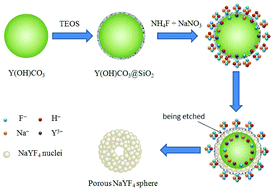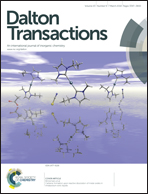Synthesis of porous upconverting luminescence α-NaYF4:Ln3+ microspheres and their potential applications as carriers†
Abstract
The present work reports a self-sacrificing template strategy to synthesize porous α-NaYF4 microspheres via the reaction of as-prepared Y(OH)CO3·H2O@SiO2 with NH4F and NaNO3 solutions. XRD, SEM, TEM and N2 adsorption–desorption measurements were used to characterize the resulting product. The surface SiO2 shell was shown to play a vital role in size and shape control and porosity formation. A possible reaction mechanism was explored in terms of a surface-protected etching and ion-exchange reaction process. To explore their application potential, the storage and release behavior of Rhodamine 640 dye in the porous α-NaYF4 microspheres was investigated, showing a relatively high loading efficiency and a sustained release ratio. Under near-infrared (NIR) irradiation, porous α-NaYF4 microspheres doped with lanthanide ions showed typical upconverting luminescence characteristics that can convert NIR photons to ultraviolet/visible photons. The above features and properties indicate that our present porous upconverting luminescence particles are promising in biological applications as luminescence imaging agents and drug carriers.


 Please wait while we load your content...
Please wait while we load your content...